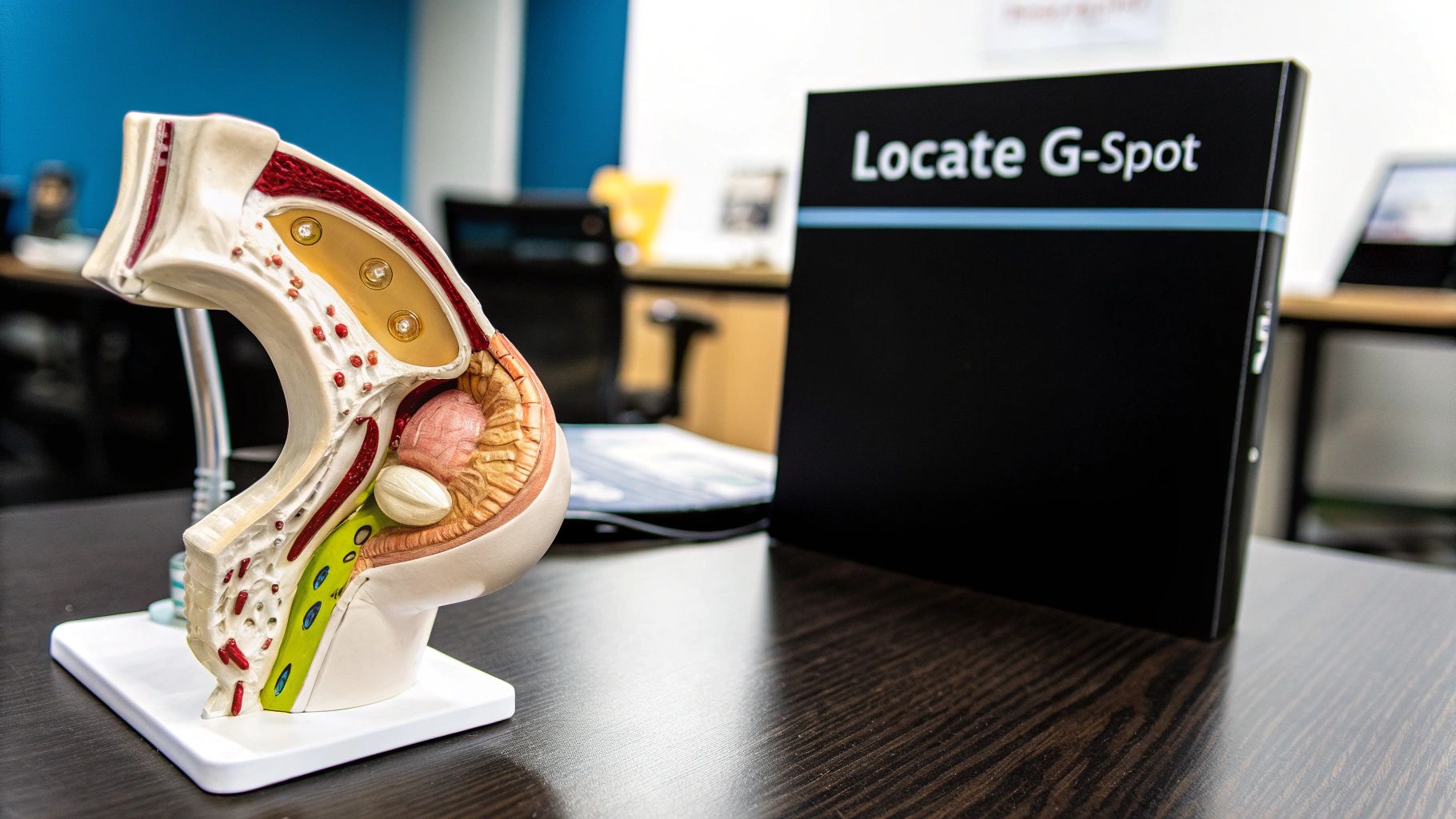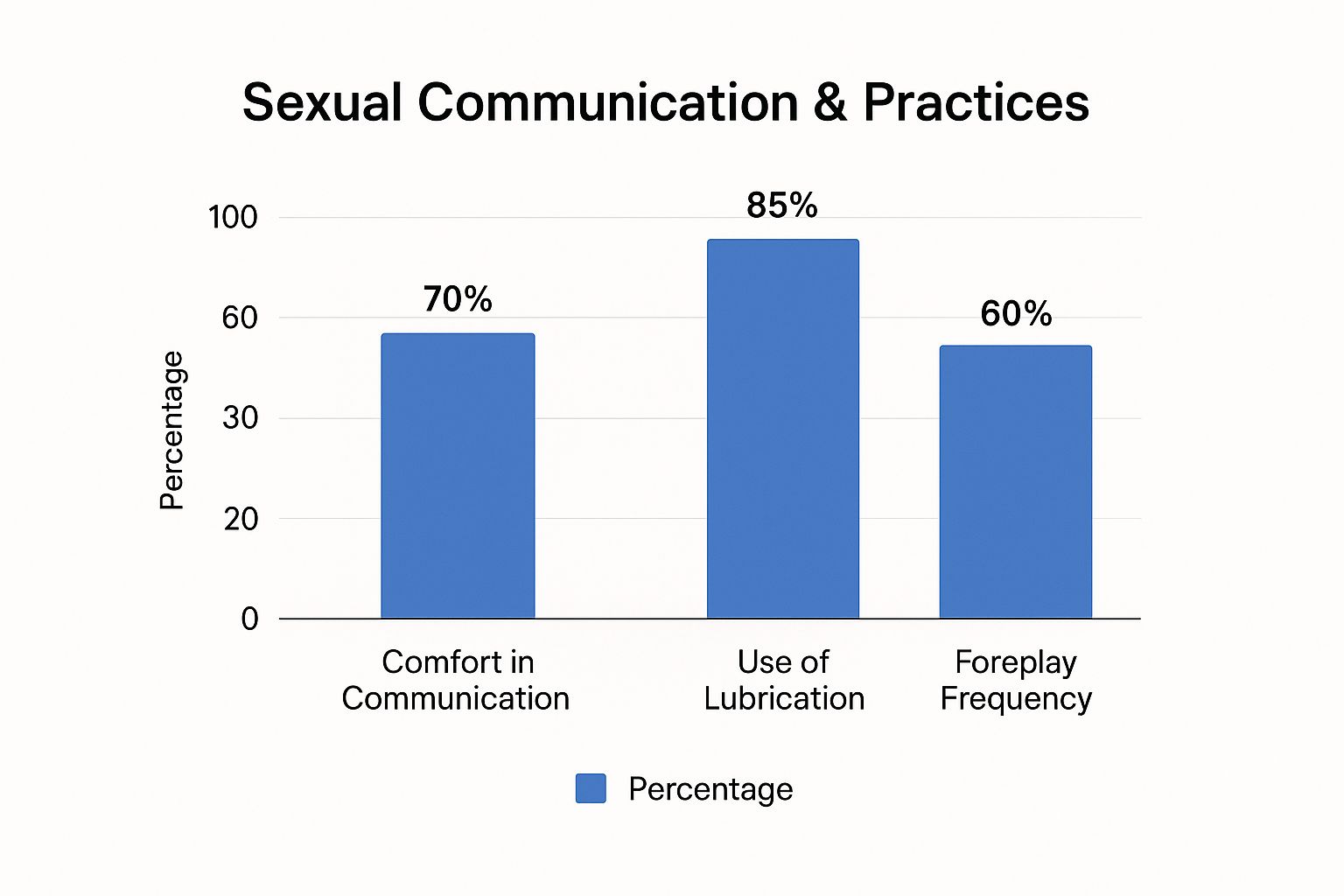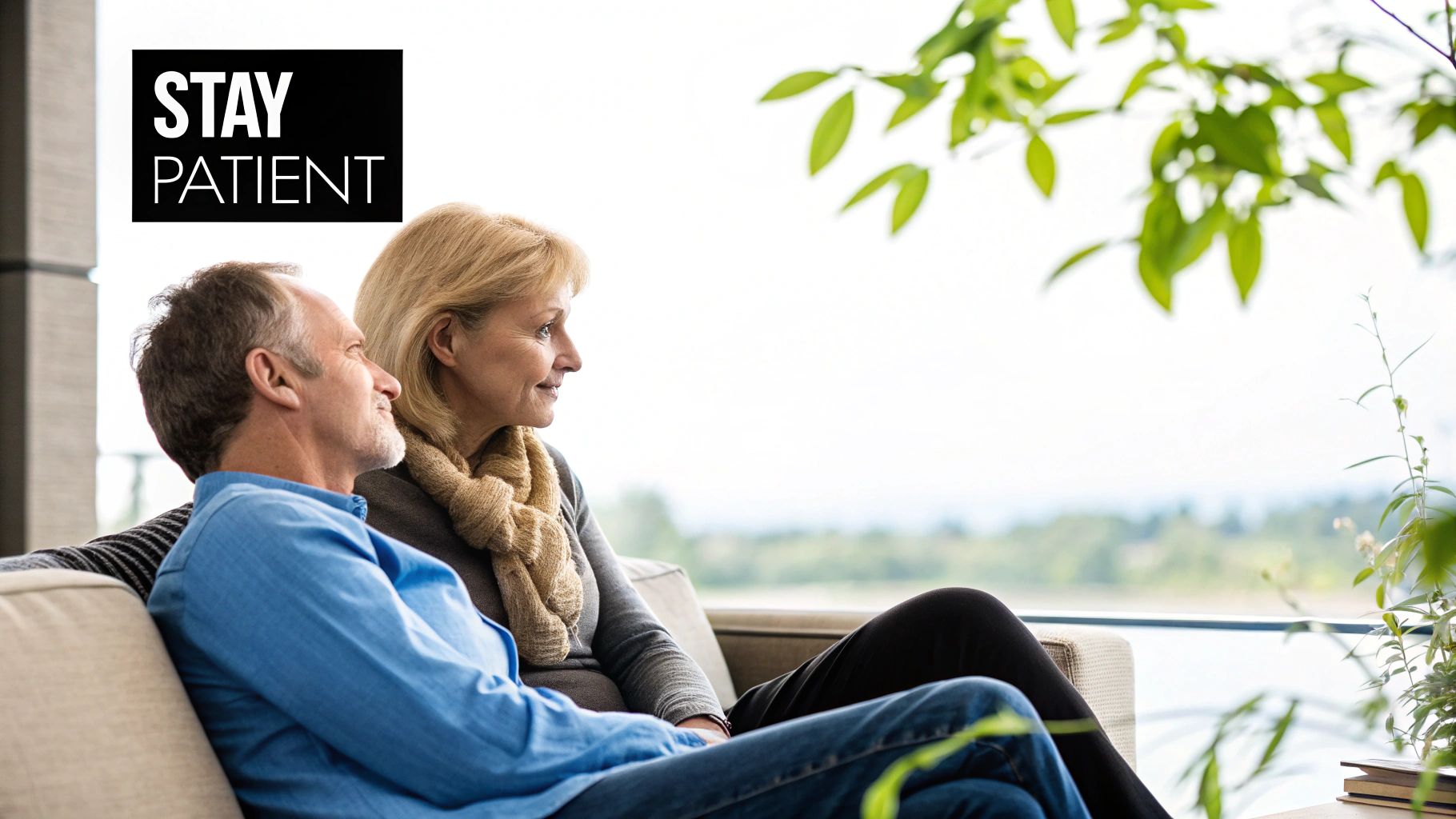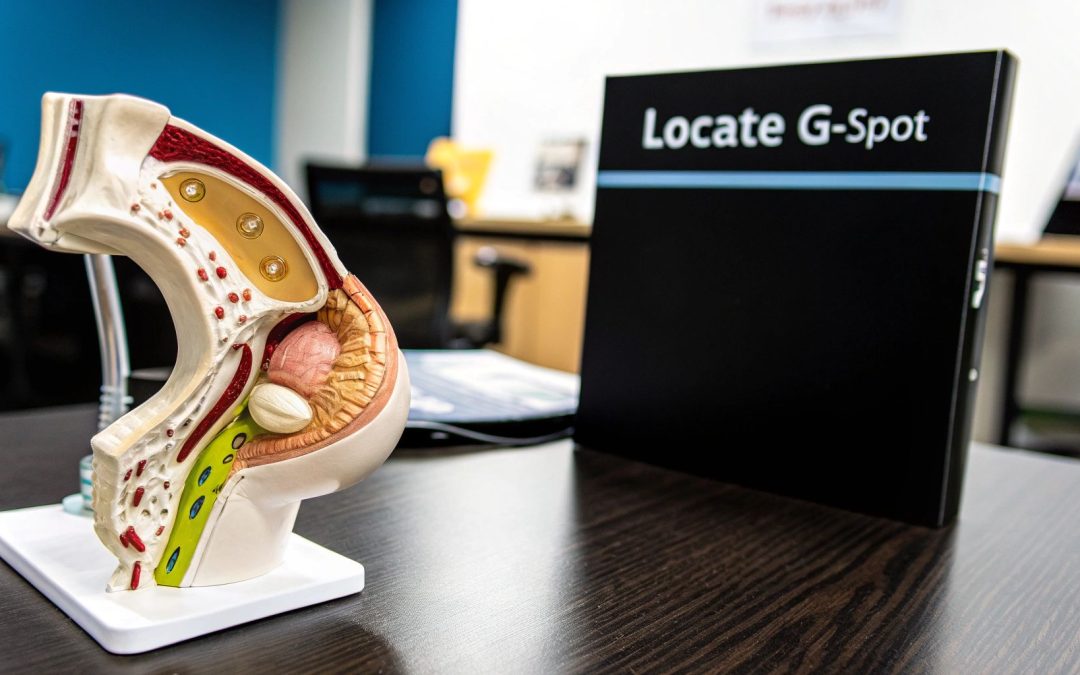Understanding What Science Actually Tells Us About The G-Spot
The G-spot, a topic often surrounded by both curiosity and confusion, is an area worth exploring. Let’s separate fact from fiction and base our understanding on scientific findings rather than common misconceptions. We’ll examine what medical research reveals about this sometimes elusive area and its connection to female sexual response.
The G-Spot: Fact vs. Fiction
The G-spot has been studied scientifically for years, yet its exact nature and location are still debated. A comprehensive review of clinical studies involving 1,842 women showed that the G-spot was identified in 55.4% of participants. This means that in over half of the women, a more sensitive or slightly swollen area was found with manual or instrument-based stimulation of the front wall of the vagina. Explore this topic further . This highlights the natural variations in women’s anatomy and experiences, meaning it’s entirely normal for some women to not have a noticeable G-spot.
The G-Spot and Surrounding Structures
To understand the G-spot, we need to consider its relationship with the surrounding areas, especially the clitoral network. Picture it as an interconnected system, where stimulating one area can affect sensations in others. This complex interaction of nerves and tissues contributes to the overall feeling of pleasure. Some women find that G-spot stimulation heightens clitoral sensitivity, while others experience it as a distinct sensation.
Individual Variations in G-Spot Sensitivity
It’s important to remember that women experience the G-spot differently. Some feel a specific highly sensitive area, while others don’t. This variation is perfectly natural and isn’t a sign of any sexual problems. Things like individual anatomy, arousal levels, and even emotional factors can influence how a woman perceives the G-spot.
Embracing Scientific Understanding for Enhanced Pleasure
By understanding the G-spot from a scientific perspective, we can have realistic expectations and appreciate the diverse nature of female sexual response. Recognizing anatomical realities and individual differences allows us to discover what feels best for each unique body, leading to greater self-awareness and increased pleasure. This knowledge provides a solid base for exploration, helping us find techniques and approaches that work best for our individual experiences.
Finding Your G-Spot: A Practical Step-By-Step Approach

So, you’re ready to learn more about the G-spot. This section offers a practical guide to help you locate and explore this area. It’s typically located on the anterior vaginal wall, about 5-8 cm inside. Remember, patience and understanding your own body are key.
Locating the G-Spot: A Guided Exploration
-
Preparation is Key: Start by emptying your bladder. A full bladder can make it difficult to relax and fully explore. Make sure you’re comfortably aroused and well-lubricated. This will make the process more comfortable and enjoyable.
-
Positioning: Try different positions to see what works best. Squatting or lying on your back with knees bent are often comfortable for self-exploration. For partnered exploration, choose positions that allow easy access to the anterior vaginal wall.
-
The “Come Hither” Motion: Insert your index or middle finger into your vagina, palm facing up. Curve your finger slightly upwards, towards your belly button, in a “come hither” motion. This helps you target the anterior wall.
-
Exploring the Area: Gently explore the area with different levels of pressure. The G-spot may feel different from surrounding tissue – possibly textured, spongy, or slightly raised. There’s ongoing debate about the G-spot’s exact anatomical basis and function. While typically described as a region on the anterior vaginal wall, about 5-8 cm inside, evidence for a distinct structure remains inconclusive. Discover more insights about the G-Spot.
-
Noticing Sensations: Pay close attention to your body’s responses. You might experience a slight urge to urinate, a feeling of fullness, or pleasurable sensations.
Partnered Exploration: Tips for Enhanced Discovery
-
Communication is Crucial: Open communication with your partner is key. Discuss what feels good and what doesn’t, and adjust your approach together.
-
Shared Exploration: Guide your partner’s hand, showing them the pressure and motion that works for you.
-
Experimenting Together: Explore different positions, speeds, and rhythms. Combining G-spot stimulation with clitoral stimulation can enhance pleasure.
Taking Breaks and Managing Expectations
Finding and stimulating the G-spot takes time and practice. Be patient and don’t get discouraged if you don’t locate it right away. If you feel discomfort, take a break and try again later. Read also: How to find the G-spot . Every woman’s anatomy is unique, and G-spot experiences vary. Focus on exploring your body, understanding what brings you pleasure, and enjoying the journey of self-discovery.
Proven Stimulation Techniques That Actually Work

The infographic above highlights key aspects of G-spot pleasure, focusing on communication, lubrication, and foreplay. 85% of respondents use lubrication, showing its importance for comfort. While 70% feel comfortable discussing their needs, there’s room for improvement. The fact that only 60% prioritize foreplay suggests its potential to enhance the G-spot experience.
Let’s explore specific techniques that can make G-spot exploration more fulfilling. Locating the G-spot is the first step, but understanding stimulation techniques unlocks its pleasure potential.
Manual Stimulation Techniques
Manual stimulation offers a direct and intimate connection with the G-spot.
-
The “Come Hither” Motion: Insert one or two fingers, palm up, and gently curl them upwards. This targets the G-spot’s location on the anterior vaginal wall. Vary the pressure, starting light and increasing as desired.
-
Circular Motions: Gentle circles directly on the G-spot can heighten sensation and allow you to explore its responsiveness.
-
The “U” Shape: Form a “U” with two fingers and gently stroke up and down. This can be particularly stimulating.
Combining G-Spot and Clitoral Stimulation
Combining these can significantly enhance pleasure.
-
Simultaneous Stimulation: While stimulating the G-spot manually or with a toy, simultaneously stimulate the clitoris with your other hand or a vibrator. This can create intense sensations.
-
Alternating Stimulation: Alternate focus between the G-spot and the clitoris for a varied and dynamic experience.
Communication and Comfort
Open communication is crucial. Learn more about how to master G-spot pleasure .
-
Clear Guidance: Show your partner the pressure and rhythm that works best.
-
Regular Check-ins: Ensure both partners are comfortable.
-
Adequate Lubrication: Lubrication is essential for comfort and enhances sensitivity.
The following table summarizes various G-spot stimulation techniques.
G-Spot Stimulation Techniques Comparison
A comparison of different stimulation methods, their benefits, and recommended experience levels.
| Technique | Description | Difficulty Level | Best For |
|---|---|---|---|
| The “Come Hither” Motion | Curling fingers upwards towards the belly button | Beginner | Direct stimulation |
| Circular Motions | Small, gentle circles on the G-spot | Beginner | Exploring sensitivity |
| The “U” Shape | Up-and-down motion with two fingers forming a “U” | Intermediate | Increased stimulation |
| Simultaneous Stimulation | G-spot and clitoral stimulation at the same time | Intermediate | Intense sensations |
| Alternating Stimulation | Switching between G-spot and clitoral focus | Intermediate | Varied experience |
This table provides a quick reference for different techniques, ranging from beginner-friendly to more advanced options. Experiment to find what works for you.
Experimentation and Patience are Key
Every woman’s body is different. Be patient, experiment, and discover what brings you the most pleasure.
Choosing The Right Tools For Enhanced Exploration

While manual stimulation is often satisfying for G-spot exploration, certain tools can significantly heighten pleasure and sensation. This section explores G-spot specific toys and their unique features, guiding you through the options available and helping you find what works best for you and your partner.
Understanding G-Spot Toy Design
G-spot toys are intentionally crafted with specific design elements to target the G-spot. Understanding these features can help you make informed decisions.
-
Curve: The defining characteristic of most G-spot toys is their curve. This curve mirrors the shape of the anterior vaginal wall, allowing for more effective and direct pressure against the G-spot.
-
Firmness: G-spot toys are available in a range of firmness levels. Some are softer and more pliable, offering gentle stimulation, while others are firmer for more intense sensations. Experimentation is key to finding what you enjoy.
-
Size: Size, considering both length and girth, is a critical factor. Starting with smaller sizes and progressively exploring larger options as comfort increases is a good approach. For further information, check out this resource: Sex toys that please the G-spot .
Safety and Hygiene
Prioritizing safety and hygiene is crucial when using any intimate product.
-
Material: Choose body-safe materials like silicone or glass. These materials are non-porous and easy to clean, reducing the risk of infection.
-
Cleaning: Thoroughly clean your toys after each use with warm water and a dedicated toy cleaner.
Introducing Toys into Partnered Play
Integrating toys into your intimate life can add excitement and deepen intimacy, but open communication with your partner is paramount.
-
Discuss Preferences: Talk openly with your partner about their comfort levels and any concerns they might have.
-
Start Slow: Introduce toys gradually, beginning with less intense options and exploring together what feels pleasurable for both of you.
-
Make it Playful: Maintain a lighthearted and playful atmosphere. Experiment with different toys and positions to discover shared preferences.
When to Use Tools vs. Manual Techniques
Both tools and manual techniques have their own distinct benefits. Manual stimulation offers a direct connection and allows for nuanced control of pressure and rhythm. Tools, however, can offer more consistent stimulation and open up possibilities for exploring different sensations. Try both approaches to determine what you prefer.
Navigating the World of Intimate Products
The wide array of intimate products available can feel overwhelming. Don’t hesitate to experiment and discover what resonates with your body and desires. Read reviews, ask questions, and never feel pressured to try anything you’re not comfortable with. The journey of exploration should be enjoyable and empowering. Remember, finding the right tools is a deeply personal journey, and what works for one person might not work for another. Prioritize your comfort, and approach exploration with curiosity and an open mind.
Why Individual Differences Matter More Than You Think

Understanding G-spot stimulation and what works for you is a personal journey. It’s about self-discovery, not reaching a specific destination. A crucial part of this journey involves recognizing that everyone’s experience is different. This section explores why individual differences matter more than many guides acknowledge.
The Impact of Anatomy and Age
Every woman’s internal anatomy is unique, just like her face. The G-spot’s location and sensitivity can vary significantly, and this is completely normal. Age also plays a role. Hormonal shifts that occur as women age can influence sensitivity and responsiveness.
Some women might notice their G-spot becomes more sensitive over time, while others might find it becomes less so. This natural variation is a vital part of understanding your own body. A 2018 study examined this topic, involving 295 women with an average age of 35.8. The study found that 51.1% of women affirmed the G-spot’s existence, 29.1% denied it, and 19.7% were unsure. Find more detailed statistics here.
Experience and Arousal Patterns: Key Factors in G-Spot Pleasure
Past sexual experiences, both positive and negative, can influence how a woman responds to G-spot stimulation. What feels pleasurable for one woman might not feel the same for another.
Individual arousal patterns are also important. Some women might need direct clitoral stimulation to enhance G-spot pleasure. Others might find the area easily responsive on its own. Understanding your personal arousal triggers is essential.
Debunking Myths and Addressing Concerns
One common misconception is that every woman should experience intense pleasure from G-spot stimulation. This isn’t necessarily true. Some women might not experience distinct G-spot sensations, and that’s perfectly normal. It doesn’t indicate any issues with their sexual health or responsiveness.
Open communication with your partner is essential. Sharing your experiences and preferences without judgment can deepen intimacy and lead to more satisfying sexual encounters.
The Influence of Overall Well-being
Several factors can affect G-spot sensitivity, including stress, hormonal changes, certain medications, and overall health. High stress levels, for example, can make it difficult to relax and fully experience pleasure. Hormonal fluctuations during menstruation or pregnancy can also impact sensitivity. These factors highlight the strong connection between mind and body in sexual response.
When to Seek Professional Guidance
If you experience persistent pain or discomfort during G-spot exploration, or have concerns about your sexual health, it’s always wise to consult a healthcare professional. They can offer personalized advice and address any potential underlying medical issues.
There’s no shame in seeking professional guidance. It’s a proactive step toward understanding your body and improving your sexual well-being. By acknowledging and embracing individual differences, you can approach G-spot exploration with realistic expectations and a focus on your unique experience. This journey is about discovering what works for you, not following a one-size-fits-all approach.
Overcoming Common Obstacles And Frustrations
Discovering the G-spot and the pleasure it can bring is often a journey of exploration. It’s not always a quick find, and that’s perfectly normal. This section addresses common challenges and offers solutions to help you navigate the process with more confidence. We’ll cover practical tips for troubleshooting, managing expectations, and knowing when it’s time to seek professional advice.
Difficulty Locating the G-Spot
Finding the G-spot isn’t always immediate. Don’t feel discouraged if you don’t locate it right away.
Vary Your Approach: Experiment with different positions, both solo and with a partner. Try various angles and levels of pressure. What feels right in one position might not in another.
Consider Your Arousal: The G-spot is typically easier to find when you’re fully aroused. Make sure you’re using enough lubrication and engage in pleasurable activities beforehand.
Don’t Focus Solely on the G-Spot: Pleasure is about exploring your whole body. Incorporate different types of stimulation and discover what feels good to you.
Managing Discomfort
Some individuals experience discomfort during G-spot stimulation. Here’s how to address that:
Use Plenty of Lubricant: Lubrication is key for comfortable exploration. Try different types of lubricant to find what works best for you.
Adjust Pressure and Angle: If something feels uncomfortable, adjust the pressure, angle, or even the type of stimulation. Small changes can make a big difference.
Communicate With Your Partner: Open communication is crucial for a positive experience. Let your partner know what feels pleasurable and what doesn’t.
Dealing With Unrealistic Expectations
The G-spot isn’t a guaranteed “magic button” for intense pleasure. Everyone experiences sensation differently.
Embrace Individual Differences: G-spot sensitivity varies greatly. Some experience intense pleasure, while others may not experience distinct G-spot sensations at all.
Focus on Your Overall Pleasure: Don’t get fixated on the G-spot. Explore other erogenous zones and enjoy the process of self-discovery. Pleasure is a journey, not a destination.
Troubleshooting and Maintaining Motivation
If your initial attempts aren’t what you expected, don’t give up.
Take Breaks: If you’re feeling frustrated, take a break and come back to it later. A fresh perspective can be helpful.
Experiment with Different Techniques: Refer back to earlier sections for guidance on stimulation techniques and using tools. There are many resources available to help you.
Consider Professional Advice: If you’re experiencing persistent challenges, consider seeking advice from a healthcare provider or a sex therapist .
Safety Considerations and Red Flags
G-spot exploration is generally safe, but it’s important to be aware of potential issues.
- Pain or Discomfort: Persistent pain or discomfort should be checked by a healthcare professional.
- Bleeding: Unexplained bleeding warrants a consultation with a doctor.
- Changes in Discharge: Significant changes in vaginal discharge could indicate an infection and should be addressed by a healthcare provider.
To help you navigate the process, we’ve compiled a table of common challenges and solutions:
Common G-Spot Exploration Challenges and Solutions
A practical guide to overcoming frequent obstacles during G-spot exploration.
| Challenge | Possible Causes | Solutions | When to Seek Help |
|---|---|---|---|
| Difficulty Locating | Insufficient arousal, anatomical variations | Vary positions, increase arousal, experiment with angles | If concerns persist after trying different approaches |
| Discomfort | Lack of lubrication, too much pressure | Use more lubricant, adjust pressure | If pain is persistent or severe |
| Lack of Intense Sensation | Unrealistic expectations, individual differences | Focus on overall pleasure, explore other erogenous zones | If you have concerns about your sexual health |
By understanding these common obstacles and implementing these practical solutions, you can navigate G-spot exploration with more confidence and enjoyment. Remember, open communication, patience, and self-compassion are key to a positive and fulfilling experience.
Key Takeaways For Your Exploration Journey
This section offers a practical guide to exploring the G-spot with confidence and realistic expectations. We’ll translate the information we’ve discussed into actionable steps you can use right away. We’ll cover essential preparation, effective techniques, and ongoing discovery strategies that respect your individual experience.
Preparing For Exploration: Setting The Stage For Success
Before you start, take these important steps to create a comfortable and inviting atmosphere:
-
Open Communication: If exploring with a partner, talk openly about your intentions and what you both want. Honest communication builds a foundation of trust and mutual respect.
-
Prioritize Relaxation: Stress and anxiety can make exploration difficult. Create a relaxing environment with soft lighting, calming music, or anything that helps you unwind.
-
Ensure Ample Lubrication: Sufficient lubrication is key for comfort and increases sensitivity. Water-based lubricants are generally recommended for their compatibility with most toys.
-
Focus on Comfort: Try different positions to find what feels best for you. Some people find squatting or lying on their back with knees bent comfortable for self-exploration.
Proven Exploration Techniques: A Guide to Discovery
Now that you’re prepared, let’s look at some effective techniques for G-spot exploration:
-
The “Come Hither” Motion: Insert one or two fingers into the vagina, palm facing up, and gently curl them upwards towards the belly button. This motion targets the G-spot’s typical location on the front wall of the vagina.
-
Varying Pressure and Rhythm: Experiment with different amounts of pressure and rhythmic patterns. Begin with gentle touches and slowly increase the intensity as desired.
-
Combining G-Spot and Clitoral Stimulation: For many women, stimulating the G-spot and clitoris at the same time can significantly increase pleasure.
Embracing Ongoing Discovery: Respecting Your Unique Timeline
Remember, finding and enjoying the G-spot is a personal journey. There’s no single right way to experience it.
-
Patience is Key: Don’t be discouraged if you don’t find the G-spot right away or if your experience is different from what you’ve read. Every woman’s anatomy is unique.
-
Self-Compassion and Acceptance: Be kind to yourself and avoid self-criticism. Concentrate on exploring your body and discovering what feels good.
-
Open Communication with Your Partner: Regular check-ins with your partner are essential. Share your experiences and preferences openly to create a space for mutual learning and exploration.
Key Success Factors: Patience, Communication, and Self-Awareness
The most important elements for a successful G-spot exploration are patience, open communication, and self-compassion. Remember, there’s no set timeline or guaranteed outcome. Sexual exploration is deeply personal. Embrace your individual journey and discoveries. Focus on learning about your body and what brings you pleasure.
Ready to learn more about the G-spot and discover its potential for increased intimacy and pleasure? Visit G-Spot 101 for helpful resources and expert guidance on all aspects of G-spot exploration.
The post How to Get G-Spot: Tips for Better Pleasure & Satisfaction appeared first on G Spot 101 .
Intimate Tickles found this article quite interested, and we thought you might to. We give all the credit for this article to gspot. Click Here To Read This Article From It's Original Source



